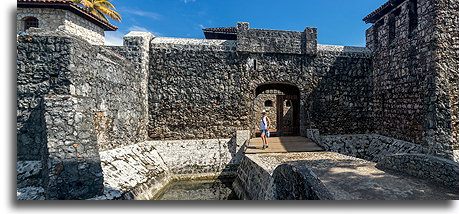Spanish castle and Maya stelae
December 4
After spending a night near hotel La Cabaña del Viejo, we headed to a Spanish fort from the 17th century. A small fortress existed to secure Spanish interests in the area. The fort located is on the shore of Lake Izabal, which connects to the Caribbean Sea; therefore, it was necessary back then to provide protection against frequent pirate attacks.




Built of stone, Castillo de San Felipe de Lara has a truly European feeling. Entrance leads via a drawbridge over the moat. The roof covered is with tiles, there are towers, and the entire defensive structure has a double outer wall. All the corridors inside are narrow, just like in the castles of the Old World.




On the way from Lake Izabal to Antigua Guatemala, we could not miss important ruins. Quiriguá was a Maya city located at the crossroads of trade routes. It was probably founded by the great city of Tikal in order to expand the territory of influence. Quiriguá was a vassal state of the nearby Copán and remained strongly aligned with Tikal for most of its history. After victory over Copán in 738, Quiriguá gained independence. Around AD 850 the city lost its ruling elite and its urban development halted.




There are not many restored buildings in Quiriguá, but the site's importance lies in its wealth of sculptures. Local sandstone is very strong and allowed sculptors of Quiriguá to erect many monuments, the tallest freestanding stone monumental sculptures ever erected in the New World. Stelae located here have long panels of glyphic text considered the most complex and beautiful among all Maya stone inscriptions.




Stelae are vertical slabs containing figures carved in low relief with an accompanying hieroglyphic text. They were essentially erected to glorify the rules, their deeds with relation to gods. They recount war victories, rituals, and commemorate important events, all with very specific dates. Their placement at the base of pyramids or in large open plazas suggests that they were intended to be viewed by vast audiences in conjunction with other public spectacles. At the end if the Classic Period, the Maya ceased to carving stelae, the last known one was erected in AD 910.




Maya people were literate. They recorded their knowledge and the history in books called codices. In the mid-16th century, Franciscan missionaries from Spain destroyed almost all of these books during their systematic conquest and colonization. Only three survived to this day. With lost codices, we lost the knowledge of long and complex history of Maya civilization. When three centuries later, early explores such as John Lloyd Stephens and Frederick Catherwood discovered Maya lost cities deep in the jungle, they thought that such enormous structures were raised by an unknown civilization. They could not imagine that the ancestors of the people who lived around could built the pyramids. Maya codices are gone, but stelae survived. Archeologist can now piece together most of the stories recorded there. This is writing the Maya history from scratch.


The road to Antigua Guatemala was quite tiring, especially after dark, mainly due to the enormous traffic. We had to pass through the capital of the country. We saw a completely different face of Guatemala here, modern shopping centers, crowded roads, traffic jams, and countless billboards everywhere. People seemed to live well here. What we saw did not quite fit Guatemala's stereotype as a very poor country.









